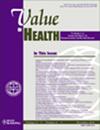为 PedsQL™ 4.0 通用核心量表开发健康状况分类系统,用于在澳大利亚进行基于偏好的估值。
IF 4.9
2区 医学
Q1 ECONOMICS
引用次数: 0
摘要
目的:儿科生活质量量表(Pediatric Quality of Life InventoryTM Version 4.0 Generic Core Scales,简称 PedsQL GCS)由 23 个项目组成,涵盖四个分量表(身体、情绪、社交和学校功能),是一种广泛应用的儿童健康相关生活质量通用测量方法,但不能为基于成本效益的决策提供健康效用。本研究旨在开发一个可用于澳大利亚健康效用推导的 PedsQL GCS 简化项目版本:数据来源于《澳大利亚儿童纵向研究》的两个队列,包括所有 PedsQL GCS 版本(幼儿、幼儿、儿童、青少年)的代理回复,以及包含儿童版本自我报告的 CheckPoint 样本。三个分析样本分别是CheckPoint 样本(n=1,874)、Mallinson 样本(n=7,855)和幼儿样本(n=7,401)。探索性和确认性因素分析对维度进行了评估。心理测量分析对每个样本随机抽取的三个子样本(样本数=500)采用了 Rasch 和经典标准。项目选择优先考虑在 CheckPoint 样本中的心理测量表现,同时也考虑在其他样本中的表现和概念内容:维度评估没有为测量结果生成其他经验结构,因此对原有的四个子量表进行了心理测量分析。选定的项目有身体机能:"疼痛";情绪机能:"悲伤/忧郁";社会功能:"其他孩子不是朋友";学校功能:"跟上学校功课":最终的四项目集(有待进一步的心理计量验证和评估)可以从广泛使用的儿童生活质量量表 GCS 中生成健康效用,为基于成本效益的决策提供依据。本文章由计算机程序翻译,如有差异,请以英文原文为准。
Development of a Health-State Classification System for the Pediatric Quality-of-Life Inventory Version 4.0 Generic Core Scales for Preference-Based Valuation in Australia
Objectives
Pediatric Quality-of-Life Inventory Version 4.0 Generic Core Scales (PedsQL GCS), comprising 23 items covering 4 subscales (physical, emotional, social, and school functioning), is a widely applied generic measure of childhood health-related quality of life but does not provide health utilities for cost-effectiveness-based decision making. This study aimed to develop a reduced item version of PedsQL GCS amenable to health utility derivation in Australia.
Methods
Data sources were 2 cohorts of the Longitudinal Study of Australian Children, including proxy responses for all PedsQL GCS versions (Toddlers, Young Children, Children, and Teens), and the CheckPoint sample containing child self-report to the Children version. Three analytic samples were CheckPoint sample (n = 1874); Mallinson sample containing 1 measurement per child from one of the Young Children, Children, or Teens versions (n = 7855); and Toddlers sample (n = 7401). Exploratory and confirmatory factor analyses assessed dimensionality. Psychometric analyses used Rasch and classical criteria on 3 randomly selected subsamples (n = 500) per sample. Item selection prioritized psychometric performance in the CheckPoint sample, also considering performance in other samples and conceptual content.
Results
Dimensionality assessments did not generate an alternative empirical structure for the measure, and psychometric analyses were conducted on the original 4 subscales. The selected items were: “Get aches and pains” for physical functioning; “Feel sad/blue” for emotional functioning; “Other kids not friends” for social functioning; and “Keeping up with school work” for school functioning.
Conclusions
The final 4-item set, pending further psychometric validation and valuation, can generate health utilities from the widely used PedsQL GCS to inform cost-effectiveness-based decision making.
求助全文
通过发布文献求助,成功后即可免费获取论文全文。
去求助
来源期刊

Value in Health
医学-卫生保健
CiteScore
6.90
自引率
6.70%
发文量
3064
审稿时长
3-8 weeks
期刊介绍:
Value in Health contains original research articles for pharmacoeconomics, health economics, and outcomes research (clinical, economic, and patient-reported outcomes/preference-based research), as well as conceptual and health policy articles that provide valuable information for health care decision-makers as well as the research community. As the official journal of ISPOR, Value in Health provides a forum for researchers, as well as health care decision-makers to translate outcomes research into health care decisions.
 求助内容:
求助内容: 应助结果提醒方式:
应助结果提醒方式:


